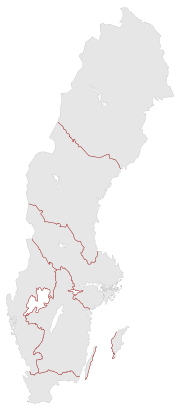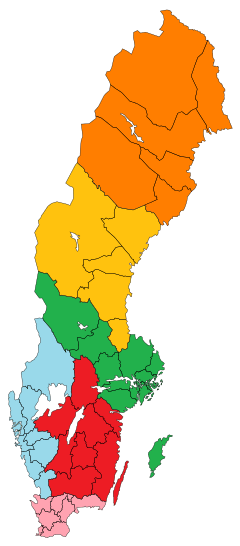Courts of appeal in Sweden
The courts of appeal in Sweden (Swedish: hovrätt) are the second instance on issues relating to criminal cases, contentious cases and other judicial issues that have already been dealt with by a district court. The next and final instance is the Supreme Court (Swedish: Högsta domstolen). The appellate court may in some circumstances require a leave to appeal, meaning they will only proceed with a case if there is reason to believe they would arrive at a conclusion different to that of the district court.[1][2]
Organization

The courts of appeal have jurisdiction in appeals from the district courts. The territorial jurisdiction (Swedish: domkrets), dividing Sweden into nine court districts, is based on the geographic boundaries of several district courts, as prescribed by the government. The courts of appeal are:[3]
| Name | Seat |
|---|---|
| Svea Court of Appeal | Stockholm |
| Göta Court of Appeal | Jönköping |
| Scania and Blekinge Court of Appeal | Malmö |
| Court of Appeal for Western Sweden | Gothenburg |
| Court of Appeal for Southern Norrland | Sundsvall |
| Court of Appeal for Northern Norrland | Umeå |
The largest is Svea Court of Appeal, covering twenty judicial districts.[1] In the courts of appeal, a judge other than the president of a court or a division of a court is titled Judge of Appeal (Swedish: hovrättsråd). A judge who presides over a division is titled Senior Judge of Appeal (Swedish: hovrättslagman), and the head official of the appellate court is titled President, Court of Appeal (Swedish: hovrättspresident).[4][5]
Approximately 650 people work for the courts of appeal in Sweden. Each court of appeal is divided into a number of departments, headed by a Senior Judge of Appeal or the President. There are also more than 600 lay judges (Swedish: nämndeman) linked to the courts of appeal. Lay judges are laymen, not legally qualified representatives of the people, appointed by the county councils, serving four years at a time. The appellate court make use of lay judges in criminal cases only.[1][6]
Quorum of the court
The main rule in civil cases is that the appellate court should consist of three legally qualified judges, but there are some exceptions to this rule. At least four legally qualified judges are required to sit for the adjudication of the case, if the district court consisted of three legally qualified judges. If one of the legally qualified judges is prevented from adjudicating after the commencement of the main hearing, the bench nevertheless constitutes a quorum.[3][6]
In criminal cases, three legally qualified judges and two lay judges constitute a quorum. If there is no reason to impose a sanction more severe than fines in a criminal case, three legally qualified judges constitute a quorum. If one of the legally qualified judges or one of the lay judges are prevented from adjudicating after the commencement of the main hearing, the bench nevertheless constitutes a quorum.[3][6]
Special courts
Svea Court of Appeal is, in addition to the its regular responsibilities as the appellate court for the districts, also responsible for appeals for some of the special courts, like the rent tribunals. The Land and Environment Court of Appeal (Swedish: Mark- och miljööverdomstolen) is also part of the Svea Court of Appeal.[1]
Appeal
A leave to appeal is required for a case to be considered by the highest instance in civil and criminal cases, the Supreme Court. This is granted by the Supreme Court itself, and only done when it is deemed important to establish a precedent for the lower courts.[7]
List and map of general courts
Court of Appeal for Southern Norrland
|
Court of Appeal for Western Sweden
Scania and Blekinge Court of Appeal
|
 |
The map shows geographic boundaries of the general courts, i.e. the district courts and its appellate court.
See also
Notes
- 1.^ List of district courts on the official website of the Swedish National Courts Administration and SFS 1982:996.
References
- 1 2 3 4 "Court of appeal". Swedish National Courts Administration. Retrieved 30 July 2014.
- ↑ "Hovrätt" (in Swedish). Swedish National Courts Administration. Retrieved 30 July 2014.
- 1 2 3 "The Swedish Code of Judicial Procedure". The Swedish Government. Archived from the original on 12 November 2013. Retrieved 30 July 2014.
- ↑ "Legal professions - Sweden". European Council. Retrieved 30 July 2014.
- ↑ "Glossary for the Courts of Sweden" (PDF). Swedish National Courts Administration. Retrieved 30 July 2014.
- 1 2 3 "Antalet domare i hovrätten" (in Swedish). lag24.se. Retrieved 30 July 2014.
- ↑ "The Supreme Court". SNCA. Retrieved 30 July 2014.